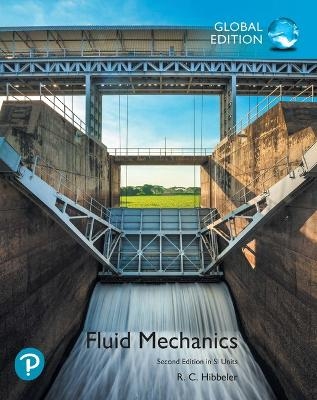
Fluid Mechanics in SI Units
Pearson Education Limited (Verlag)
978-1-292-24730-4 (ISBN)
Fluid Mechanics is intended to provide a comprehensive guide to a full understanding of the theory and many applications of fluid mechanics. The text features many of the hallmark pedagogical aids unique to Hibbeler texts, including its student-friendly, clear organisation. The text supports the development of student problem-solving skills through a large variety of problems, representing a broad range of engineering disciplines that stress practical, realistic situations encountered in professional practice, and provide varying levels of difficulty. The text offers flexibility in that basic principles are covered in chapters 1-6, and the remaining chapters can be covered in any sequence without the loss of continuity.
Updates to the 2nd Edition result from comments and suggestions from colleagues, reviewers in the teaching profession, and many of the author’s students, and include expanded topic coverage and new Example and Fundamental Problems intended to further students’ understanding of the theory and its applications.
R. C. Hibbeler graduated from the University of Illinois at Urbana with a BS in Civil Engineering (majoring in Structures) and an MS in Nuclear Engineering. He obtained his PhD in Theoretical and Applied Mechanics from Northwestern University. Professor Hibbeler's professional experience includes postdoctoral work in reactor safety and analysis at Argonne National Laboratory, and structural and stress analysis work at Chicago Bridge and Iron, as well as at Sargent and Lundy in Chicago. He has practiced engineering in Ohio, New York, and Louisiana. Professor Hibbeler currently teaches both civil and mechanical engineering courses at the University of Louisiana - Lafayette. In the past, he has taught at the University of Illinois at Urbana, Youngstown State University, Illinois Institute of Technology, and Union College.
1 Fundamental Concepts
1-1. Introduction
1-2. Characteristics of Matter
1-3. The International System of Units
1-4. Calculations
1-5. Problem Solving
1-6. Basic Fluid Properties
1-7. Viscosity
1-8. Viscosity Measurement
1-9. Vapor Pressure
1-10. Surface Tension and Capillarity
2 Fluid Statics
2-1. Pressure
2-2. Absolute and Gage Pressure
2-3. Static Pressure Variation
2-4. Pressure Variation for Incompressible
2-5. Pressure Variation for Compressible Fluids
2-6. Measurement of Static Pressure
2-7. Hydrostatic Forces on Plane Surfaces
2-8. Hydrostatic Forces on an Incline Plane or Curved Surface Determined by Projection
2-9. Buoyancy
2-10. Stability
2-11. Constant Accelerated Translation of a Liquid
2-12. Steady Rotation of a Liquid
3 Kinematics of Fluid Motion
3-1. Types of Flow Description
3-2. Types of Fluid Flow
3-3. Graphical Descriptions of Fluid Flow
3-4. Fluid Acceleration
3-5. Streamline Coordinates
3-6. The Reynolds Transport Theorem
4 Conservation of Mass
4-1. Rate of Flow and Average Velocity
4-2. Continuity Equation
5 Energy of Moving Fluids
5-1. Euler’s Equations of Motion
5-2. The Bernoulli Equation
5-3. Applications of Bernoulli’s Equation
5-4. Energy and the Hydraulic Gradient
5-5. The Energy Equation
6 Fluid Momentum
6-1. The Linear Momentum Equation
6-2. The Angular Momentum Equation
6-3. Propellers
6-4. Applications for Control Volumes Having Rectilinear Accelerated Motion
6-5. Turbojets
6-6. Rockets
7 Differential Fluid Flow
7-1. Differential Analysis
7-2. Kinematics of Differential Fluid Elements
7-3. Circulation and Vorticity
7-4. Conservation of Mass
7-5. Equations of Motion of a Fluid Particle
7-6. The Euler and Bernoulli Equations
7-7. The Stream Function
7-8. The Potential Function
7-9. Basic Two-Dimensional Flows
7-10. Superposition of Flows
7-11. The Navier-Stokes Equations
7-12. Computational Fluid Dynamics
8 Dimensional Analysis and Similitude
8-1. Dimensional Analysis
8-2. Important Dimensionless Numbers
8-3. The Buckingham Pi Theorem
8-4. Similitude
9 Viscous Flow Within Enclosed Surfaces
9-1. Steady Laminar Flow between Parallel Plates
9-2. Navier-Stokes Solution for Steady Laminar Flow Between Parallel Plates
9-3. Steady Laminar Flow Within A Smooth Pipe
9-3. Laminar and Turbulent Shear Stress Within a Smooth Pipe
9-4. Navier-Stokes Solution for Steady Laminar Flow Within a Smooth Pipe
9-5. The Reynolds Number
9-6. Laminar and Turbulent Shear Stress Within a Smooth Pipe
9-7. Fully Developed Flow From an Entrance
9-8. Turbulent Flow Within a Smooth Pipe
10 Analysis and Design for Pipe Flow
10-1. Resistance to Flow in Rough Pipes
10-2. Losses Occurring From Pipe Fittings And Transitions
10-3. Single Pipeline Flow
10-4. Pipe Systems
10-5. Flow Measurement
11 Viscous Flow Over External Surfaces
11-1. The Concept of the Boundary Layer
11-2. Laminar Boundary Layers
11-3. The Momentum Integral Equation
11-4. Turbulent Boundary Layers
11-5. Laminar and Turbulent Boundary Layers
11-6. Drag and Lift
11-7. Pressure Gradient Effects
11-8. The Drag Coefficient
11-9. Methods for Reducing Drag
11-10. Lift and Drag on an Airfoil
12 Turbomachine
| Erscheinungsdatum | 31.12.2019 |
|---|---|
| Verlagsort | Harlow |
| Sprache | englisch |
| Maße | 203 x 234 mm |
| Gewicht | 1420 g |
| Themenwelt | Technik ► Maschinenbau |
| ISBN-10 | 1-292-24730-4 / 1292247304 |
| ISBN-13 | 978-1-292-24730-4 / 9781292247304 |
| Zustand | Neuware |
| Haben Sie eine Frage zum Produkt? |
aus dem Bereich


